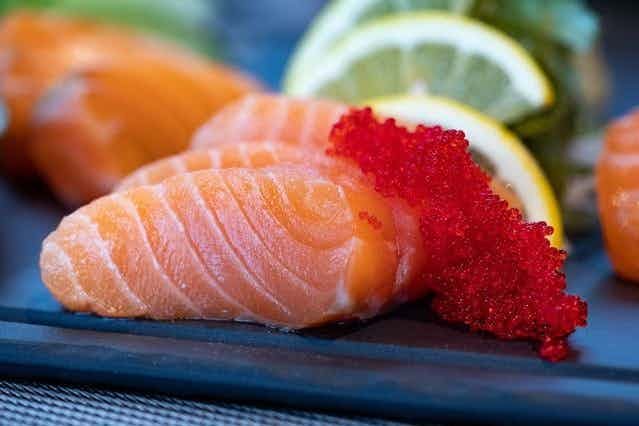Preparing raw fish may seem like an art form and a challenge and not something we should be doing in our homes. In some countries and cultures, this might be true. But there is no reason that with the right equipment, knowledge and skill you can't prepare raw fish at home and make some delicious dishes.
Frustrated with food waste or don't know where to start with a shopping list? Try a food subscription box to wash those worries away and put your diet - and finances - on the right track!
Can you eat raw fish?
When asking if you can eat raw fish, the answer is rarely a simple one. The short answer is yes, you can! However, it isn't as straightforward as that, and there are many types of fish you shouldn't even consider eating raw. Even for those fish you can eat raw, you need to ensure you buy the right fish! You also need to ensure the fish is suitable for eating raw and the fishmongers store it correctly.
What types of fish can you eat raw?
When eating in a raw fish restaurant, you will notice that they often serve only a few types of raw fish. Some of the most common are these.
- Salmon
- Tuna
- Flounder
- Snapper
- Sea Bass
These all tend to be freshwater or saltwater fish, which helps them be more suitable for eating raw.
One thing to be careful of is the grade of fish. You may find some or all of these fish in your supermarket or on your local fishmongers’ shelves. However, this doesn't necessarily make them suitable for eating raw. Eating raw fish is a tricky thing to do safely. You need to ensure you are buying high-quality fish, frozen for storage and specifically farmed to be suitable for eating raw.
Is raw fish safe to eat?
One reason we cook food is because it tastes great! Of course, this isn't the only reason. There are also lots of other more practical reasons we cook food too. Many types of food, especially animal products, contain harmful bacteria and parasites. Most of these nasty bugs get destroyed when we cook food to a specific temperature. We have all had those dodgy stomachs after eating undercooked foods, and it isn't pleasant!
Raw fish of any type will contain a certain level of bacteria. If you are not cooking the fish, you won’t destroy the bacteria. This doesn’t necessarily mean that you can’t eat raw fish safely. However, it does mean you should be aware of any risks and best practices before doing so.
When someone mentions raw fish, one of our first reactions is to worry about food poisoning. This is a risk because some fish will contain the bugs that cause food poisoning, including salmonella and listeria. If you eat these bacteria, you could end up with all the usual symptoms of an upset stomach, including sickness and diarrhoea. This isn't to say that everyone who eats raw fish will end up with a dodgy stomach! In fact, according to Healthline, if you're healthy and have a healthy immune system, you're at relatively low risk of getting ill when eating sushi or other raw fish dishes. Those with weaker immune systems, including children and the elderly, have a higher chance of getting sick.
Another issue to be aware of is the level of pollutants present in some fish are likely to be higher in raw fish when compared to cooked fish. Fish also contain other parasites and diseases, such as tapeworm and roundworm. This is why if you do plan to eat or buy raw fish, you should only buy them from a reputable restaurant or fishmonger. They can assure you the fish is of a high enough quality and stored well enough to consume raw.
Can you eat raw fish when you are pregnant?
The information available on whether you can eat raw fish while pregnant is a little confusing. When pregnant, your body is already under stress. While you would typically be able to eat sushi without any ill effect, you are at a higher risk of getting sick due to having a weakened immune system. That said, the NHS website says you can eat sushi and lightly cooked fish when pregnant as long as you're sure the supplier froze the fish first and that it comes from reputable sources.
How to buy raw fish
Buying raw fish can be a bit of a minefield! You would think that you could pop to the grocery shop or your local fishmonger and ask for sushi grade fish and be sure the fish is safe to eat raw. Unfortunately, this isn't the case. The term "sushi grade" is entirely unregulated. This means that any fish seller or producer can use it to label whatever they decide is their highest quality fish. This leads to a lot of confusion when it comes to choosing raw fish. The only regulation we do have in the UK regarding this comes from the Food Standards Agency. They do regulate the selling of raw fish for food businesses. This stipulates that you must freeze certain fish to sell for raw consumption. This also applies to any process that doesn't cook the food, including pickling and salting fish.
The best you can do is make sure you head to a fish market or fishmonger and ask them for their advice. If they can provide frozen fish to eat raw and seem knowledgeable on the subject, you can have some confidence that the fish will be fine. A reputable fishmonger should be able to talk about its suppliers, too. They will know where the fish comes from and be able to talk about the processing procedure.
These are a few tips and questions to ask when you buy your fish.
- Talk to your fishmonger, ask where the fish comes from. If they can't tell you, then avoid it and find another place. You want a fishmonger who is confident in their suppliers.
- Make sure your fishmonger knows how you intend to use the fish. They are best placed to advise you on whether you can eat their fish raw or point you in the right direction as to where to find out.
- Don't be afraid to look at the fish. A whole fish should have the eyes intact, and there should be no signs of damage or discolouration. The skin should be firm and look fresh.
- Ask your fishmonger about frozen fish.
- Also, make sure you take some time to peruse the shop in general. If you aren't comfortable with the level of hygiene or the seller, don't risk it. Food businesses in the UK must follow certain levels of hygiene. You can also check the rating of the place you buy your fish on the Food Ratings Website.
How to prepare and eat raw fish
I once went on a sushi making course. While it was great fun, and I learned a lot about how to roll and put together beautiful sushi bites, there was one disappointment. I wasn’t allowed to cut and prepare the raw fish elements myself. This was largely down to the knives and equipment required rather than the fish itself. Sashimi and sushi knives are incredibly sharp so that they can slice through the raw flesh in clean lines. This is the first tip we have for preparing your fish. Make sure you have suitable sharp knives. While a sashimi knife would be perfect, you can use a fish knife too – as long as it is sharp.
How you cut and prepare your raw fish will depend on the type of meal you are making. Even making sashimi can be different depending on the fish you intend to make. For some great beginners advice, this video from Japanese Cooking 101 is full of tips and how to make sashimi.
What types of raw fish dishes can you make?
Whilst sashimi and sushi are the most common types of raw fish dishes, there is a wide range of tasty raw fish meals from various cultures.
- Sashimi is a lovely way to eat raw fish. It has a meaty texture that melts in the mouth as you eat it. It is raw fish at its simplest with only a little dressing.
- Sushi doesn’t need to contain raw fish, but it can. This is a Japanese method of cooking and preparing food into bitesize pieces. Each mouthful feels like a meal all on its own!
- Poke is a Hawaiian dish. It is a seasoned salad of mixed vegetables mixed with chunks of bitesize raw fish.
- Carpaccio is from Italy. Traditionally you make this using thin slices of raw beef, but you can substitute the beef for raw fish.
- Koi pla is a Southern Asian dish. It is finely sliced raw fish mixed with a fish sauce and seasoned with lime juice, garlic, chilli, herbs and vegetables.
- Gravlax is a Nordic dish made from raw salmon. You cure raw salmon in sugar, salt and dill rather than cook the fish. You would then serve it with a delicious mustard sauce.
- Soused herring comes from The Netherlands. It is a process of marinating raw herring in a mild preserve such as brine or vinegar. You can add other ingredients for flavour, like sugar, herbs and spices.
We spoke to Heather from The Fish People, who told Age Times: “Whether in sushi, sashimi, ceviche, or tartare, eating raw fish can be a delicious culinary experience when done right. Our top piece of advice is to freeze wild-caught fish, like our sushi-grade tuna, for a couple of hours prior to use to kill any potential parasites."
Buying and preparing raw fish
It is possible to buy and prepare your raw fish dishes at home. This doesn't mean it is the most straightforward process. You have to ensure that you are buying fish that is safe to eat raw from a fishmonger you trust. Then you must learn the skills and recipes required. Raw fish also isn’t suitable for everyone. The bacteria and parasites in fish can make some of us ill. However, it is worth the effort if you love fresh raw fish meals. You could book yourself onto some courses or learn by yourself. Be careful to do so with caution and ensure that you don't make yourself or anyone else sick. It is one of those skills that once you know how it seems easy!








